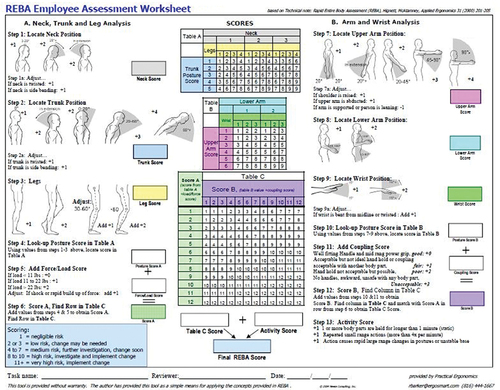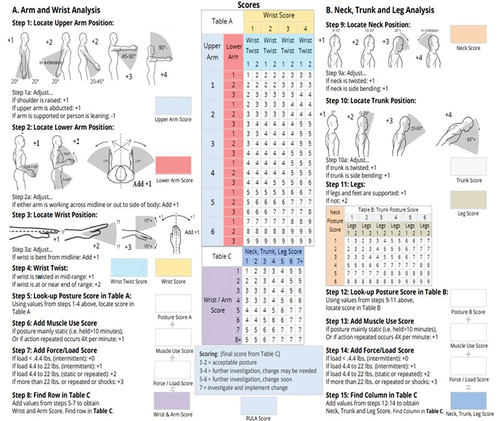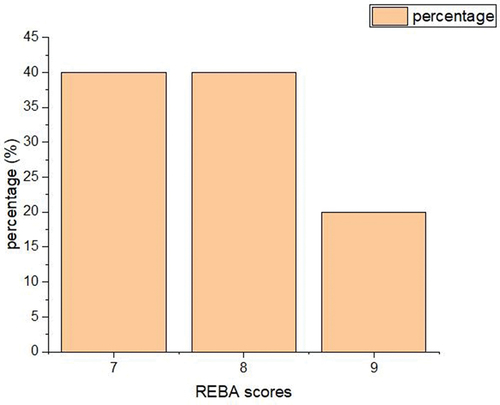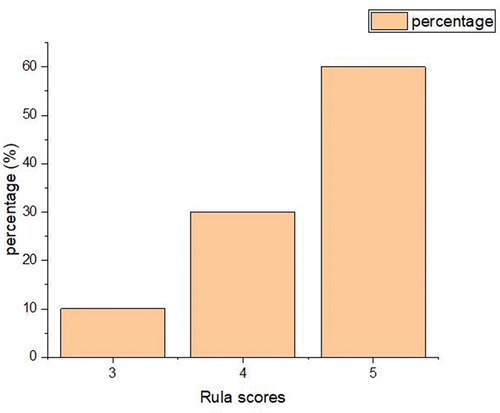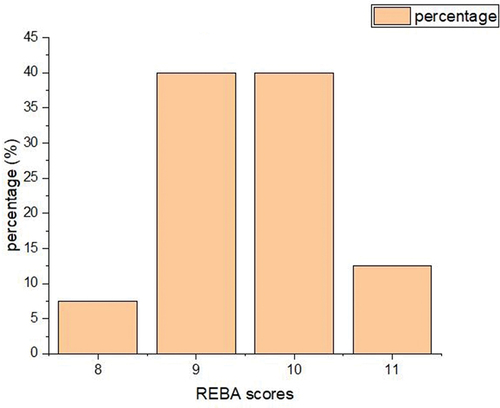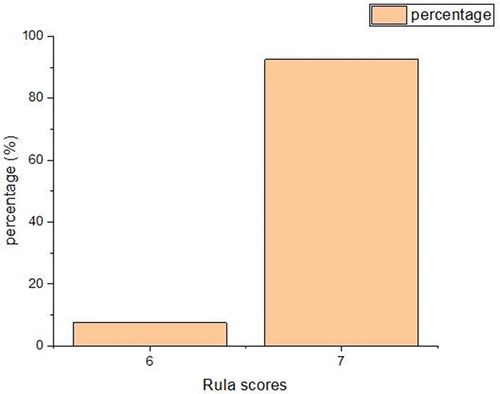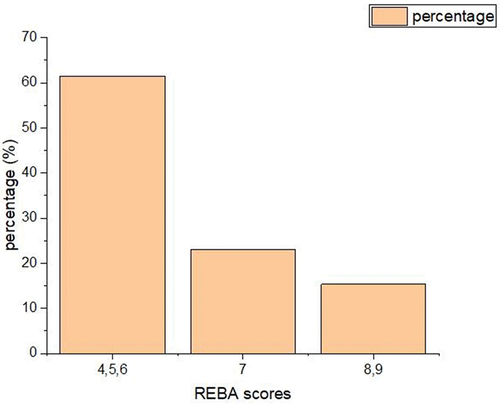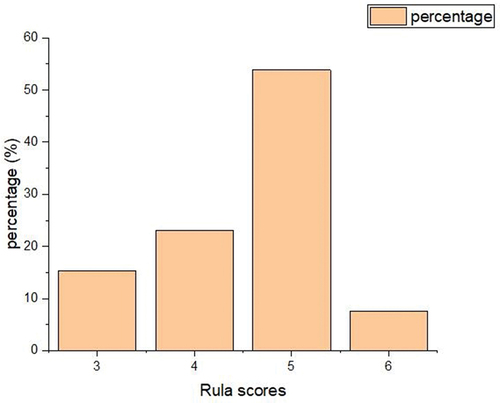ABSTRACT
Work-related musculoskeletal disorders (wMSDs) are common workplace health hazard among sewing, ironing and packing workers, which can be caused by the manual and repetitive work in the garment industry. This research evaluates and categories the risk variables for 63 people took part in the Musculoskeletal Disorders study for garment material protection. The primary goal of this research is to determine the prevalence of Musculoskeletal Disorders (MSDs) and to reduce their risk. The data were gathered using a questionnaire and an observational checklist, and the risk was calculated using the Rapid Entire Body Assessment (REBA) and Rapid Upper Limb Assessment (RULA) approach and human postures were captured by camera for analysis. Reported musculoskeletal symptoms occurring in sewing, packing, ironing are lower back pain (50%, 61.5%, 42.5%), knee (30%, 15.3%, 27.5%), wrist pain (20%, 23%, 20%), shoulder pain (40%, 46.15%, 27.5%) and neck pain (40%, 23%, 32.5%), respectively, and ironing workers reported calf pain of 52.5% were the most common sites of pain. It is critical that awkward posture, uncomfortable movements, prolonged standing, and other factors contributed to an increase in worker risk while protecting garments.
摘 要
与工作相关的肌肉骨骼疾病(wMSDs)是缝纫、熨烫和包装工人常见的工作场所健康危害,这可能是由服装行业的手工和重复性工作引起的. 这项研究评估并分类了63名参与肌肉骨骼疾病研究的人的风险变量,以保护服装材料. 这项研究的主要目标是确定肌肉骨骼疾病(MSD)的患病率并降低其风险. 使用问卷和观察检查表收集数据,使用快速全身评估(REBA)和快速上肢评估(RULA)方法计算风险,并通过摄像机捕捉人体姿势进行分析. 报告的缝合过程中出现的肌肉骨骼症状。打包、熨烫分别是下背痛(50%61.5%,42.5%)、膝盖(30%15.3%,27.5%)、手腕疼痛(20%,23%,20%)、肩部疼痛(40%,46.15%.27.5%)和颈部疼痛(40%.23%,32.5%),熨烫工人报告小腿疼痛是最常见的疼痛部位. 重要的是,尴尬的姿势、不舒服的动作、长时间的站立以及其他因素在保护衣服的同时增加了工人的风险.
Introduction
India’s garment industry is a one-trillion-rupee industry. By volume, over a third of its knitwear production and around a quarter of its woven-garment manufacturing are exported. In all, around 25% of the amount of its garment production is exported, leaving the remaining 75% for domestic use. The indirect element supports the direct production sector by providing sewing/embroidery thread, buttons, buckles, zippers, metal plates, cardboard sheets, plastic butterflies, and packaging material (Bhuvaneswaran and Jishin Jayan Citation2022). The majority of them are limited companies, with the remainder being proprietary or partnership companies. Men’s clothing is primarily made in western and southern India, whilst women’s garments are primarily created in northern India. The eastern part of India specializes in children’s clothing, which is where these were born. Cotton clothes account for 80% of output, synthetic/mixed garments for 15%, and silk and wool garments for the remaining 20% (Okareh, Solomon, and Olawoyin Citation2021). Implementing ergonomic improvements can reduce the risk factors that lead to discomfort. Ergonomic improvements can reduce the primary risk factors for MSDs, so workers are more efficient, productive, and have greater job satisfaction.
Garments and accessories are exported from India to every corner of the globe (Comper and Simprini Padula Citation2013). However, the United States, the European Union, and Canada collectively account for 70% of global exports. The rest is made up of markets in Asia, Africa, East Europe, Australia, New Zealand, and Pacific Ocean nations. India has had to embrace new techniques through improving product quality (Cheng and Yan-Ying Citation2013). As a labor-intensive industry, production and marketing have shifted to Asia, with India and China serving as the leading suppliers and markets for apparel (Wang et al. Citation2005).
Related works
The study of humans in their working environment is referred to as ergonomics. The objective is to eliminate work-related pain and injury risk. The most common problem among Indian workers appears to be occupational work injuries (Lombardo, Khan, and Khan Citation2012). People working in cottage businesses in India are unaware of the health risks associated with repeated employment. In this study, it is clear that both male and female ironing workers experience a variety of work-related problems while ironing clothes in various postures (Chaiklieng and Thanyawat Citation2019). Physical and ergonomic dangers were shown to be more closely linked to sewing machine operators than any other type of hazard. Textile sewing machine workers should be made aware of and educated on safe techniques in order to reduce dangers and long-term consequences. They may have pain as a result of their routine operations, which could result in temporary or permanent health problems. It is critical to emphasize that cohort in this study, impacts were recognized as a key constraint (Vandyck and Docea Citation2012). Partially scored biomechanical risks revealed that the cervical spine (neck) and shoulders/arms are at moderate risk, while the lumbar spine and wrists/hands are at high risk. Workers in the finishing sector had a somewhat higher perception of stress at work than those in other sections. The differences between the portions were not statistically significant (p > .05) (Ahmad et al. Citation2007). The findings revealed an 85.8% prevalence rate and a robust link between WMSDs (Sharma and Neetu Citation2019) and depression. Physical exertion and pain showed an exposure–response relationship in four body parts, with physical isometric loads above the mean increasing neck/shoulder and lower extremity discomfort (Çivitci Citation2004). Musculoskeletal pain was most common among ironers, packers, and cutters, followed by sewers, quality control assistants, and supervisors and recorders. A Body Mass Index (BMI) of 27 or higher was linked to with a 40% increase in the risk of musculoskeletal problems with age, and self-reported symptoms were more prevalent. We discovered that lower educational attainment was linked to higher rates of pain and dysfunction among garment workers, as reported previously. However, after accounting for other characteristics in our analysis, the association did not hold (Berberoğlu and Tokuç Citation2013). Individuals who had only been in the sector for a year or less were much more likely to report, muscle or joint pain, but they were reluctant to seek medical attention or take time off from work (Pun et al. Citation2004). The goal of this study was to look at the prevalence of low back pain (LBP) and the relationship between LBP and postural risk factors among female informal garment workers. A follow-up questionnaire was used to obtain data on the incidence of LBP. The standard Rapid Upper Limb Assessment (RULA) method was used to assess ergonomic risk. The nine-month LBP incidence was determined to be 30.98%, with the peak incidence occurring in the ninth month (5.99%). Shoulder flexion 45, 90 degrees, shoulder abduction, elbow flexion 60, 100 degrees, wrist twist, neck twist, and trunk twist were all found to be substantially linked with LBP. The data confirmed that the incidence of LBP increased over time, and that the working risk posture contributed to the increased risk of LBP development. The findings suggest that workers should receive ergonomics training and workstation modifications in order to maintain a safe posture while sewing (Robin et al. Citation2001). A physical discomfort survey was used to determine which injuries they linked to the performance of tasks at work. Noise, poor ventilation, improper seat heights, widths, and depths, and difficult postures were discovered as stresses (Polat, Olcay and Kalayci Citation2016).
Methodology
The study includes sewing, ironing and packing workers of garment industry. Only workers who performed a task for a lengthy duration on an average of 1 year and 6 days per week were included in the study.
Rapid Entire Body Assessment (REBA)
The Rapid Entire Body Assessment (REBA) is a method for determining the risk of musculoskeletal diseases (MSDs) related to certain employment duties (Karuppiah et al. Citation2020). It is a whole-body screening tool that assesses biomechanical and postural loads on the body using a systematic process.
Assessment worksheet for REBA is shown in .
For left and right, score was given to the postures in Group A (Trunk, Neck, and Legs) and Group B (Upper Arms, Lower Arms, and Wrists). There includes a posture score system for each location, as well as adjustment remarks for further concerns. Then, a score was provided to the factors of Load/Force and Coupling. Finally, marked the activity as a grade. For Group A posture scores, Table A was referred, and for Group B posture scores, the Table B. The tables were arranged in the same order as the data collecting page. The total of the Table A and Load/Force scores was marked as Score A. For each hand, Score B is the total of the Table B and Coupling scores. Score C was read from Table C, by entering it with the Score A and the Score B.
The REBA score is the sum of the Score C and the Activity score.
The output of the Rapid Entire Body Assessment tool is the final REBA Score, which is a single score that represents the level of MSD risk for the job task being evaluated. The minimum REBA Score = 1, and the maximum REBA Score = 15. Outlined in the above chart are the REBA level of MSD risk descriptions and cut points (Hossain et al. Citation2018).
Rapid Upper Limb Assessment (RULA)
The Rapid Upper Limb Assessment (RULA) is a workplace risk assessment tool based on ergonomics that allows to quantify the risk of musculoskeletal loading in the upper limbs and neck (Chan et al. Citation2002). Assessment worksheet for RULA is shown in .
RULA’s useful scoring system allows to take a snapshot of the highest risk posture adopted during the task (Sarder, Nabeel, and Mandahawi Citation2006). The scoring system was broken down into four action levels with indications in as to the urgency of the investigation.
Action level 1. Score of 1–2 = Acceptable
Action level 2. Score of 3–4 = Investigate further
Action level 3. Score of 5–6 = Investigate further and change soon
Action level 4. Score of 7 = Investigate further and change immediately
RULA is designed to assess the force, posture and movement associated with sedentary tasks including manufacturing, retail, computer tasks, and laboratory work or where the individual is seated or standing without moving about.
Step by step analysis
A. Arm and Wrist Analysis
Step 1: Locate Upper Arm Position:
Step 1a: Adjust. If shoulder is raised: +1 If upper arm is abducted: +1 If arm is supported or person is leaning: −1
Step 2: Locate Lower Arm Position:
Step 2a: Adjust. If either arm is working across midline or out to side of body: Add +1
Step 3: Locate Wrist Position:
Step 3a: Adjust. If wrist is bent from midline: Add +1
Step 4: Wrist Twist: If wrist is twisted in mid-range: +1 If wrist is at or near end of range: +2
Step 5: Look-up Posture Score in Table A: Using values from steps 1–4 above, locate score in Table A
Step 6: Add Muscle Use Score If posture mainly static (i.e. held >10 minutes), Or if action repeated occurs 4× per minute: +1
Step 7: Add Force/Load Score If load <.4.4 lbs. (intermittent): +0 If load 4.4 to 22 lbs. (intermittent): +1 If load 4.4 to 22 lbs. (static or repeated): +2 If more than 22 lbs. or repeated or shocks: +3
Step 8: Find Row in Table C Add values from steps 5–7 to obtain Wrist and Arm Score. Find row in Table C.
B. Neck, Trunk and Leg Analysis
Step 9: Locate Neck Position: Step 9a: Adjust … If neck is twisted: +1 If neck is side bending: +1
Step 10: Locate Trunk Position: Step 10a: Adjust … If trunk is twisted: +1 If trunk is side bending: +1
Step 11: Legs: If legs and feet are supported: +1 If not: +2
Step 12: Look-up Posture Score in Table B: Using values from steps 9–11 above, locate score in Table B
Step 13: Add Muscle Use Score If posture mainly static (i.e. held >10 minutes), Or if action repeated occurs 4× per minute: +1
Step 14: Add Force/Load Score If load <.4.4 lbs. (intermittent): +0 If load 4.4 to 22 lbs. (intermittent): +1 If load 4.4 to 22 lbs. (static or repeated): +2 If more than 22 lbs. or repeated or shocks: +3
Step 15: Find Column in Table C Add values from steps 12–14 to obtain Neck, Trunk and Leg Score. Find Column in Table C
Result and discussion
show the REBA, RULA scores for sewing, ironing and packing machine operators.
Table 1. REBA scores for sewing, ironing and packing operators.
Table 2. RULA scores for sewing, ironing and packing operators.
show the percentage of REBA and RULA scores for sewing, ironing and packing machine operators.
Average REBA AND RULA scores for sewing machine operators (10 numbers) are 9 and 5, respectively. As the REBA score is 9, the respondents are at very high risk and no one at low risk and in safe zone in sewing activity. Action should be taken immediately for such activity. However, RULA score indicates that respondents are at medium risk.
Average REBA AND RULA scores for ironing workers are 10 and 7, respectively, for 40 people. As the REBA and RULA score is 10 and 7, the respondents are at very high risk and no one at low risk and in safe zone in ironing activity. This is in line with the earlier investigation and actions should be taken immediately (Sarder, Nabeel, and Mandahawi Citation2006). RULA score indicates that the respondents are at medium risk.
Average REBA AND RULA scores for packing workers are 8–9 and 6, respectively, for 13 people. As the REBA score is 8–9, respondents are at very high risk and no one at low risk and in safe zone in packing activity. Thus, action should be taken immediately to reduce the risk.
Pain identified
From the questionnaire, data collection percentage of pains identified in neck, shoulder, wrist, lower back, and knee is common site of pain in sewing, ironing and packing. Calf pain is especially seen in ironing workers.
Musculoskeletal symptoms are occurring in sewing, packing, ironing as lower back pain (50%, 61.5%, 42.5%), knee pain (30%, 15.3%, 27.5%), wrist pain (20%, 23%, 20%), shoulder pain (40%, 46.15%, 27.5%) and neck pain (40%, 23%, 32.5%), respectively, and calf pain of 52.5% is the most common sites of pain in ironing. This can happen when mechanical or structural problems develop in the spine, discs, muscles, ligaments, or tendons in the back.
Musculoskeletal disorders are the group of disorders which affect the muscles, tendons, ligaments, joints, peripheral nerves and supporting blood vessels in the body. Sewing machine involves continuous, repetitive tasks like cutting, assembly, pressing and finishing. These works are performed in a sitting posture with upper back curved forwards and the head is bent toward the sewing machine. Working in this faulty posture for a long time increases the chance of developing work-related musculoskeletal disorder among them.
Conclusion
Risk of musculoskeletal diseases (MSDs) related to certain employment duties in cotton garment industry was investigated by evaluating biomechanical and postural loads on the body by using REBA technique. The risk of musculoskeletal loading in the upper limbs and neck during garmenting operation was assessed on the basis of RULA technique.
The prevalence of musculoskeletal disorders is high in this study. It is critical that awkward posture, uncomfortable movements, prolonged standing, and other factors contributed to an increase in worker risk particularly in India. In order to ameliorate the current catastrophic situation of garment industry employees in sewing, packing and ironing areas, it is desired to reduce their ergonomic hazards and to protect the material.
Disclosure statement
No potential conflict of interest was reported by the authors.
References
- Ahmad, S. -K., M. H. Akhtar, S. Sayed, M. H. Khan, M. H. Faruquee, N. Yesmin, A. F. Sarwar, M. Z. Hossain, P. Begum, and A. B. Selimuzzaman. 2007. Musculoskeletal disorders and ergonomic factors among the Garment Workers. Journal Prevent Social Media 26 (2) :97–10.
- Berberoğlu, U., and B. Tokuç. 2013. Work-related musculoskeletal disorders at two textile factories in Edirne, Turkey. Balkan Medical Journal 30:23. doi:10.5152/balkanmedj.2012.069.
- Bhuvaneswaran, P., and T. Jishin Jayan. 2022. Study on postural analysis and musculoskeletal disorder Risk on the domestic ironing workers. International Research Journal of Engineering and Technology 9:962–67.
- Chaiklieng, S., and H. Thanyawat. 2019. Incidence and postural risk factors for low back pain among informal garment female workers. International Conference on Applied Human Factors and Ergonomics, Springer, Cham.
- Chan, J., J. Ira, N. Lashuay, A. Stern, K. Fong, and R. Harrison. 2002. Preventing musculoskeletal disorders in garment workers: Preliminary results regarding ergonomics risk factors and proposed interventions among sewing machine operators in the San Francisco Bay Area. Applied occupational and environmental hygiene 17:247–53. doi:10.1080/10473220252826547.
- Cheng, H.Y.K., and Yan-Ying. 2013. Work-related musculoskeletal disorders and ergonomic risk factors in special education teachers and teacher’s aides. BMC Public Health 16:1–9. doi:10.1186/s12889-016-2777-7.
- Çivitci, Ş. 2004. An ergonomic garment design for elderly Turkish men. Applied Ergonomics 35:243–51. doi:10.1016/j.apergo.2004.02.001.
- Comper, M. L. C., and R. Simprini Padula. 2013. Ergonomic risk assessment in textile industry workers by two instruments: Quick exposure check and job factors questionnaire. Fisioterapia e Pesquisa 20:215–21. doi:10.1590/S1809-29502013000300004.
- Hossain, D., I. M. Mohammad, M. H. Al Imam, I. Mahmud, I. A. Chowdhury, R. I. Kabir, and M. Sarker. 2018. Prevalence of work related musculoskeletal disorders and ergonomic risk assessment among readymade garment workers of Bangladesh: A cross sectional study. PLoS One 13:e0200122. doi:10.1371/journal.pone.0200122.
- Karuppiah, K., S. Mithun Ali, S. M. Ali, and G. Kabir. 2020. Role of ergonomic factors affecting production of leather garment-based SMEs of India: Implications for social sustainability. Symmetry 12:1414. doi:10.3390/sym12091414.
- Lombardo, R. S., A. R. Khan, and J. Khan. 2012. Musculoskeletal symptoms among female garment factory workers in Sri Lanka. International Journal of Occupational and Environmental Health 18:210–19. doi:10.1179/1077352512Z.00000000029.
- Okareh, O. T., O. E. Solomon, and R. Olawoyin. 2021. Prevalence of Ergonomic hazards and persistent. Work-related musculoskeletal pain among textile sewing machine operators. Safety Science 136:1051–59. doi:10.1016/j.ssci.2021.105159.
- Olcay, P., and C. B. Kalayci. 2016. Ergonomic risk assessment of workers in garment industry. Eight international conference on textile science & economy VIII, Zranjanin, Sarbia.
- Pun, J. C., B. Burgel, J. Chan, and N. Lashuay. 2004. Education of garment workers:Prevention of work related musculoskeletal disorders. Aaohn Journal 52:338–43. doi:10.1177/216507990405200807.
- Robin, H., J. Dropkin, N. Warren, D. Sivin, J. Doucette, L. Kellogg, J. Bardin, D. Kass, and S. Zoloth. 2001. Impact of a joint labor-management ergonomics program on upper extremity musculoskeletal symptoms among garment workers. Applied Ergonomics 32:453–60. doi:10.1016/S0003-6870(01)00024-2.
- Sarder, N. I., M. Nabeel, and N. Mandahawi. 2006. Ergonomic workplace evaluation of an Asian garment-factory. Journal of Human Ergology 35:45–51.
- Sharma, R., and R. Neetu. 2019. Ergonomics followed in sewing room in apparel industry. Journal of Basic and Applied Engineering Research 6 (3):192–97.
- Vandyck, E., and A. G. Docea. 2012. The work practices and ergonomic problems experienced by garment workers in Ghana. International Journal of Consumer Studies 36:486–91. doi:10.1111/j.1470-6431.2011.01066.x.
- Wang, P. C. D., J. Robert, C. Jacqueline, R. Beate, J. CHAN, and I. JANOWITZ. 2005. Work organization and work-related musculoskeletal disorders for sewing machine operators in garment industry. Annals of Epidemiology 15:655. doi:10.1016/j.annepidem.2005.07.026.

